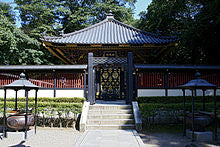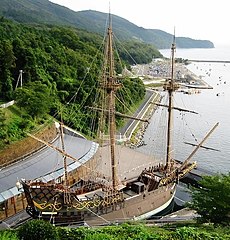
Date Masamune
Share
Date Masamune (伊達 政宗) (Yonezawa, September 5, 1567 - June 27, 1636) was a Japanese samurai from the Azuchi-Momoyama Period to the early Edo Period. Heir to a long line of powerful daimyo in the Tōhoku region, he founded the present city of Sendai. A great strategist, he was even more iconic for having lost one eye, and Masamune was often called dokuganryū (独眼竜), the "one-eyed dragon."
Date Masamune Firstly

Date Masamune was the eldest son of Date Terumune, born in Yonezawa Castle (in present-day Yamagata Prefecture). At age 14, in 1581, Masamune led his first campaign, helping his father take on the Sōma family.
In 1584, at age 18, Masamune succeeded his father, Terumune, who decided to retire from his position as daimyo. The Date family was founded in the early Kamakura Period by Isa Tomomune, who originally came from the Isa district of Hitachi Prefecture (present-day Ibaraki Prefecture).
The family took its name from the Date district (present-day Fukushima prefecture) of Mutsu prefecture, which was given to Isa Tomomune by Minamoto no Yoritomo, the first Kamakura shogun, for his help in the Genpei Wars (1180-85) and in Minamoto no Yoritomo's struggle for power against his brother, Minamoto no Yoshitsune.
Date Masamune's troop is recognized by its black armor and golden helmet. In the Sengoku Basara game series, he is a playable character, and constantly speaks in English
Date Masamune Historical Figure

Masamune is known for a few things that set him apart from other daimyo of his time. In particular, his famous crescent-shaped helmet gave him a fearsome reputation. In childhood, smallpox robbed him of the sight of his right eye, though it is not known for certain how he lost the entire organ.
Some sources say that he removed the eye himself when a senior member of the clan reminded him that an enemy might seize it in combat. Others say that his trusted servant Katakura Kojūrō removed the eye for him.
Because of his lost eye, his own mother deemed him unfit to be leader of the clan and began to prefer his younger brother for the post.
The Date clan built alliances with neighboring clans through intermarriage over the generations. However, there were several disputes over their land in the 15th and 16th centuries.
Soon after Masamune's succession, a servant of the Date named Ōuchi Sadatsuna passed to the Ashina clan of the Aizu region. Masamune declared war on the Ashina for treason, but his army was stopped by the Ashina general Iwashiro Morikuni, who forced Masamune to withdraw from the campaign. Masamune took control of Obama's castle after that.
With Masamune's rise, old friendly relations were put aside as he began to attack and conquer all surrounding lands, even those of his relatives in Mutsu and Dewa. Shocked by his ruthlessness, a neighboring family, Hatakeyama, desperately appealed to Date Terumune to control their son's military campaigns.
Invited to dinner by the Hatakeyama, Terumune said he would not be able to control his son. In an act of desperation, the family kidnapped Terumune and tried to take him with them. Masamune, who was out hunting, was warned of the kidnapping.
When he and his men encountered the kidnappers, who were about to cross a river, Terumune ordered his son's men to kill all their enemies, even at the cost of his own life.
Masamune's men did so and killed everyone, including Terumune. Masamune continued the war and tortured and eliminated all the families of his father's kidnappers.
After defeating the Ashina in 1589, he made the Aizu domain his base of operations.
Meanwhile, his relationship with his mother, Yoshihime, continued to deteriorate. Yoshihime insisted that Masamune renounce the succession in favor of her second son, Kojiro. According to some historians, she tried to poison him one night while making dinner.
Masamune consequently killed his own brother to attain power. After this tragedy, his mother fled to her brother's home, the Mogami clan. However, their relationship was later restored.
According to research by Ken-ichi Sato, Masamune wrote a letter in which he stated his appreciation for his mother's financial help during the campaign in Korea in 1593. Ken-ichi Sato, Date Masamune no tegami (Letters from Date Masamune).
In 1590, Toyotomi Hideyoshi seized Odawara Castle and compelled the daimyos of the Tōhoku region to participate in the campaign. Although Masamune first refused Hideyoshi's demands, he had no choice, for Hideyoshi was the virtual leader of Japan.
Masamune still demurred, angering Hideyoshi. Expecting to be executed, Masamune, wearing his best clothes and showing no fear, faced his master. Not wanting trouble, Hideyoshi spared his life, saying that "he might be of some use".
After serving Hideyoshi for a time, he was given Iwatesawa Castle and the surrounding lands as his personal domain. Masamune moved there in 1591, remade the castle, renamed it Iwadeyama, and encouraged the growth of a town at its base.
Masamune stayed in Iwadeyama for 13 years and turned the region into a major political and economic center. He and his men served with distinction in the invasions of Korea under Hideyoshi, and after Hideyoshi's death he began supporting Tokugawa Ieyasu - apparently on the advice of Katakura Kojūrō.
Tokugawa Ieyasu rewarded Masamune with the large and lucrative domain of Sendai, which made Masamune one of the most powerful daimyo in Japan.
Tokugawa promised Masamune a domain of one million koku, but even after substantial improvements were made, the land produced only 640,000 koku, most of which fed the Edo region. In 1604, Masamune, accompanied by 52,000 vassals and their families, moved to the then small fishing village Sendai.
He left his fourth son, Date Muneyasu, ruling Iwadeyama. Masamune would turn Sendai into a large and prosperous city.
Although Masamune was a patron of the arts and sympathetic to foreign causes, he was also an aggressive and ambitious daimyo.
Just when he took over the Date clan, he suffered some defeats from powerful and influential clans like Ashina. These defeats were undoubtedly caused by recklessness on Masamune's part.
Being one of the most powerful in northern Japan, Masamune was naturally viewed with suspicion, as any potential rival could be viewed. Toyotomi Hideyoshi reduced the size of his lands after his delay in attending the siege of Odawara against Hōjō Ujimasa.
Subsequently, Tokugawa Ieyasu increased his holdings again, but was constantly suspicious of Masamune and his policies. He was particularly suspicious of foreign missionaries, seen as a threat to his power. Therefore, he ordered the execution of Father Sotelo after his journey around the world.
Although Tokugawa Ieyasu and allies of the Date clan viewed him with suspicion, Date Masamune for the most part served the Tokugawa and Toyotomi loyally.
He participated in Hideyoshi's campaigns in Korea and the campaigns in Osaka. When Tokugawa Ieyasu was on his deathbed, Masamune visited him and read a piece of a Zen poem. Masamune was highly respected for his ethics; one aphorism still quoted is, "Righteousness carried to excess hardens into rigidity; benevolence beyond measure sinks into weakness."
Date Masamune Patron of culture and Christianity

Masamune expanded trade in the formerly remote region of Tōhoku. Although he initially faced attacks from hostile clans, he overcame them after a few defeats and then ruled one of the largest fiefdoms of the Tokugawa shogunate.
He built several palaces and worked on several projects to beautify the region. He is also known to have encouraged foreigners to come to his lands. It is unlikely that Masamune himself was secretly a Christian convert.
Although he founded and promoted a retinue to establish relations with the pope in Rome, he was probably at least partly motivated by a desire for foreign technology, similar to that of other lords such as Oda Nobunaga.
Also, after Tokugawa Ieyasu made Christianity illegal, Masamune revised his position and, albeit begrudgingly, let Ieyasu persecute Christians in his domain. For 270 years, Tōhoku remained a place of tourism, trade, and prosperity. Matsushima, for example, a series of small islands, was praised for its beauty and serenity by the wandering haiku poet Matsuo Bashō.
He showed sympathy to Christian missionaries and traders in Japan. In addition to allowing preaching in his territory, he also released the prisoner Father Sotelo from the hands of Tokugawa Ieyasu. Date Masamune let Sotelo, as well as other missionaries, practice his religion and make conversions in Tōhoku.
Masamune's greatest achievement was founding and sponsoring one of Japan's few overseas journeys of diplomacy and exploration. He ordered the construction of the Date Maru or San Juan Bautista ship, using foreign (European) ship building techniques.
He sent one of his servants, Hasekura Tsunenaga, Sotelo, and an embassy of 180 people on a voyage to establish relations with the pope in Rome.
The expedition visited places like the Philippines, Mexico, Spain, and Rome, being the first Japanese voyage to sail around the world. Previously, no Japanese lord had ever funded ventures of this size, so it was probably the first successful voyage.
At least five members of the expedition stayed in Coria (Seville) of Spain to avoid persecution of Christians from Japan. 600 of their descendants, with the surname Japón, live in Spain today.
When the Tokugawa government banned Christianity, Masamune had to obey the law. However, some sources suggest that Masamune's eldest daughter, Iroha, was a Christian.
Date Masamune Family
- Pai
- Date Terumune
- Mãe
- Yoshihime, filha de Mogami Yoshimori, daimyo da província de Dewa
- Esposa
- Megohime, filha de Tamura Kiyoaki, dono do castelo de Miharu na província de Mutsu
- Filhos
- Date Hidemune (1591-1658), primeiro dono do domínio de Uwajima
- Date Tadamune (1599-1658)
- Date Munekatsu (1621-1679)
- Date Munekiyo (1600-1634)
- Date Munetsuna (1603-1618)
- Date Munetaka (1607-1626)
- Date Munesane (1613-1665)
- Irohahime (1594-1661)
- Primos
- Date Shigezane (1568-1646)

